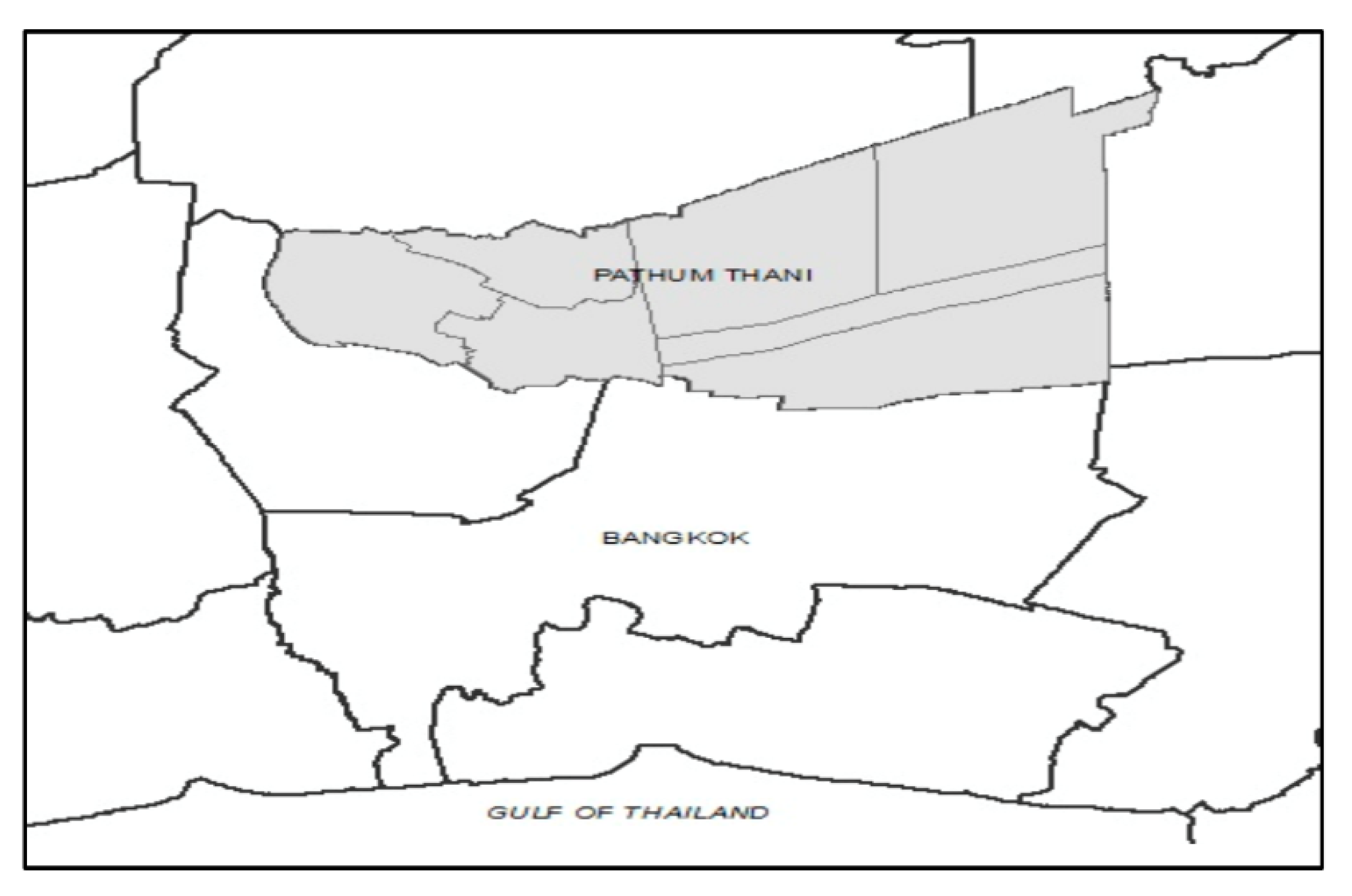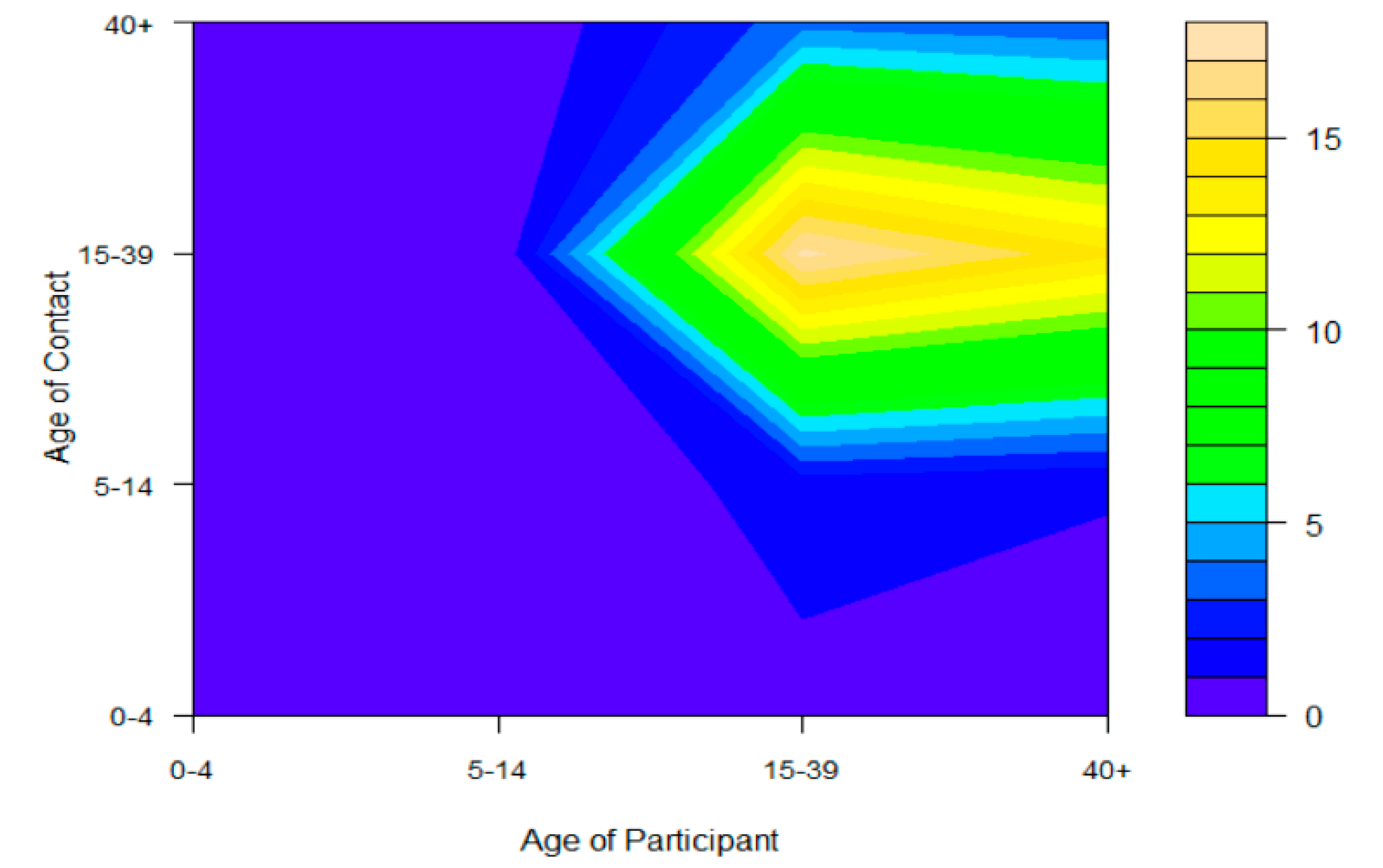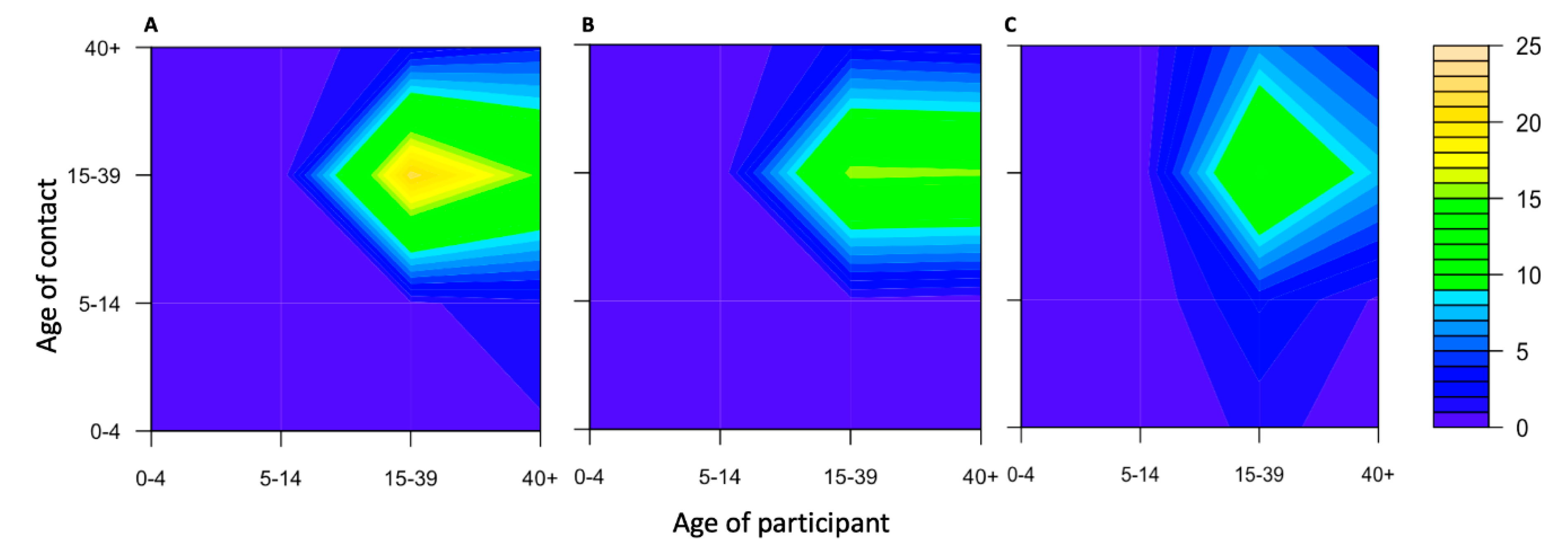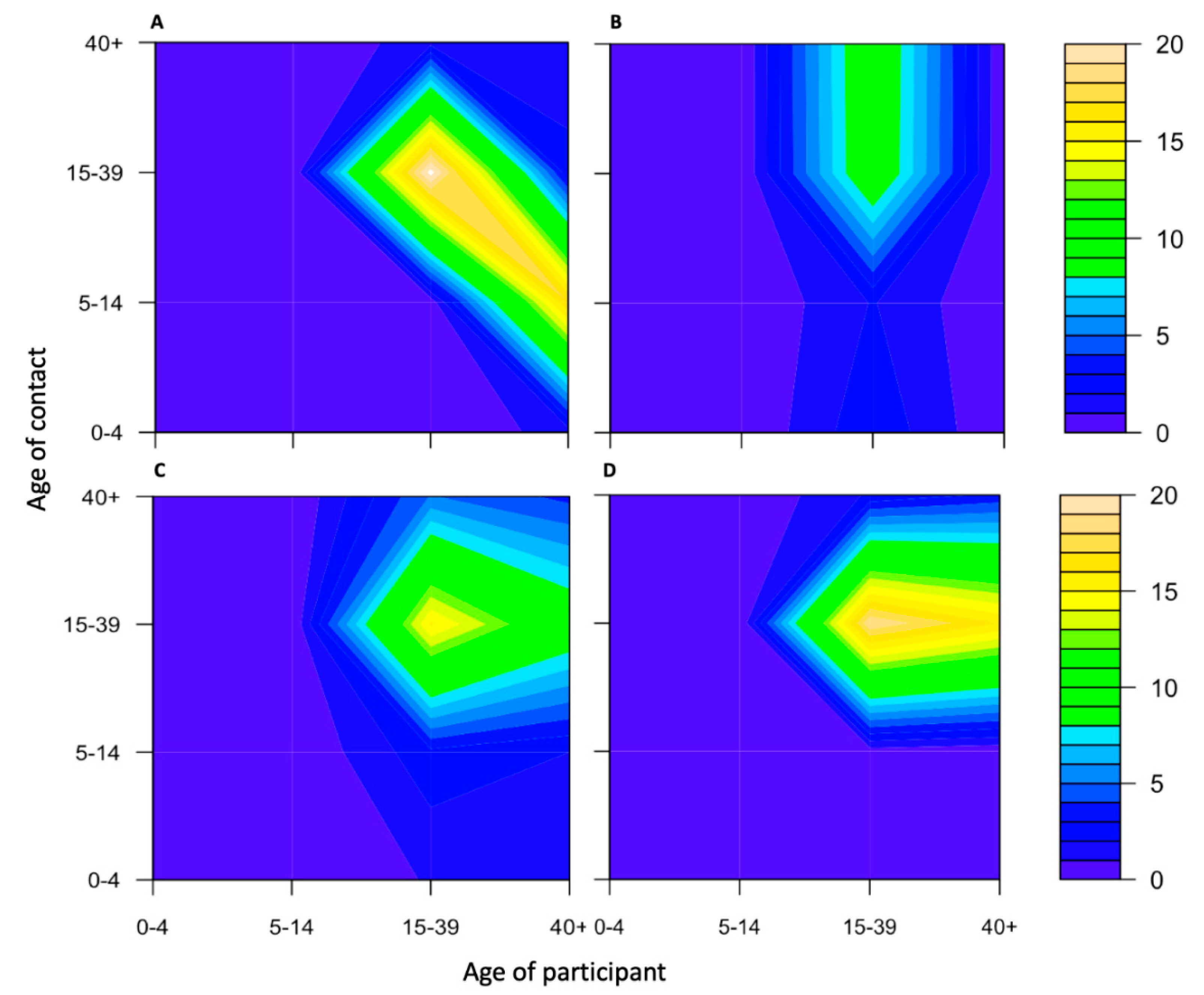Contact Mixing Patterns and Population Movement among Migrant Workers in an Urban Setting in Thailand
Abstract
1. Introduction
2. Materials and Methods
2.1. Study Area and Data Collection
2.2. Data Analysis
3. Results
4. Discussion
5. Conclusions
Author Contributions
Funding
Acknowledgments
Conflicts of Interest
References
- Del Valle, S.Y.; Hyman, J.M.; Chitnis, N. Mathematical models of contact patterns between age groups for predicting the spread of infectious diseases. Math. Biosci. Eng. 2013, 10, 1475–1497. [Google Scholar] [PubMed]
- Bansal, S.; Grenfell, B.T.; Meyers, L.A. When individual behaviour matters: Homogeneous and network models in epidemiology. J. R. Soc. Interface 2007, 4, 879–891. [Google Scholar] [CrossRef] [PubMed]
- Keeling, M.R.P. Modeling Infectious Diseases in Humans and Animals; Princeton University Press: Princeton, NJ, USA, 2008. [Google Scholar]
- Volz, E.M.; Miller, J.C.; Galvani, A.; Ancel Meyers, L. Effects of heterogeneous and clustered contact patterns on infectious disease dynamics. PLoS Comput. Biol. 2011, 7, e1002042. [Google Scholar] [CrossRef]
- Wu, J.; Dhingra, R.; Gambhir, M.; Remais, J.V. Sensitivity analysis of infectious disease models: Methods, advances and their application. J. R. Soc. Interface 2013, 10, 20121018. [Google Scholar] [CrossRef] [PubMed]
- Aral, S.O. Patterns of sexual mixing: Mechanisms for or limits to the spread of STIs? Sex. Transm. Infect. 2000, 76, 415–416. [Google Scholar] [CrossRef] [PubMed]
- Laumann, E.O.; Youm, Y. Racial/ethnic group differences in the prevalence of sexually transmitted diseases in the United States: A network explanation. Sex. Transm. Dis. 1999, 26, 250–261. [Google Scholar] [CrossRef]
- Youm, Y.; Laumann, E.O. Social network effects on the transmission of sexually transmitted diseases. Sex. Transm. Dis. 2002, 29, 689–697. [Google Scholar] [CrossRef]
- Datta, S.; Mercer, C.H.; Keeling, M.J. Capturing sexual contact patterns in modelling the spread of sexually transmitted infections: Evidence using Natsal-3. PLoS ONE 2018, 13, e0206501. [Google Scholar] [CrossRef]
- Mossong, J.; Hens, N.; Jit, M.; Beutels, P.; Auranen, K.; Mikolajczyk, R.; Massari, M.; Salmaso, S.; Tomba, G.S.; Wallinga, J.; et al. Social contacts and mixing patterns relevant to the spread of infectious diseases. PLoS Med. 2008, 5, e74. [Google Scholar] [CrossRef]
- Wallinga, J.; Teunis, P.; Kretzschmar, M. Using data on social contacts to estimate age-specific transmission parameters for respiratory-spread infectious agents. Am. J. Epidemiol. 2006, 164, 936–944. [Google Scholar] [CrossRef]
- Meeyai, A.; Praditsitthikorn, N.; Kotirum, S.; Kulpeng, W.; Putthasri, W.; Cooper, B.S.; Teerawattananon, Y. Seasonal influenza vaccination for children in Thailand: A cost-effectiveness analysis. PLoS Med. 2015, 12, e1001829. [Google Scholar] [CrossRef] [PubMed]
- Horby, P.; Pham, Q.T.; Hens, N.; Nguyen, T.T.; Le, Q.M.; Dang, D.T.; Nguyen, M.L.; Nguyen, T.H.; Alexander, N.; Edmunds, W.J.; et al. Social contact patterns in Vietnam and implications for the control of infectious diseases. PLoS ONE 2011, 6, e16965. [Google Scholar] [CrossRef] [PubMed]
- Le Polain de Waroux, O.; Cohuet, S.; Ndazima, D.; Kucharski, A.J.; Juan-Giner, A.; Flasche, S.; Tumwesigye, E.; Arinaitwe, R.; Mwanga-Amumpaire, J.; Boum, Y., 2nd; et al. Characteristics of human encounters and social mixing patterns relevant to infectious diseases spread by close contact: A survey in Southwest Uganda. BMC Infect. Dis. 2018, 18, 172. [Google Scholar] [CrossRef] [PubMed]
- Prem, K.; Cook, A.R.; Jit, M. Projecting social contact matrices in 152 countries using contact surveys and demographic data. PLoS Comput. Biol. 2017, 13, e1005697. [Google Scholar] [CrossRef] [PubMed]
- Munasinghe, L.; Asai, Y.; Nishiura, H. Quantifying heterogeneous contact patterns in Japan: A social contact survey. Theor. Biol. Med. Model. 2019, 16, 6. [Google Scholar] [CrossRef]
- Stein, M.L.; van Steenbergen, J.E.; Buskens, V.; van der Heijden, P.G.; Chanyasanha, C.; Tipayamongkholgul, M.; Thorson, A.E.; Bengtsson, L.; Lu, X.; Kretzschmar, M.E. Comparison of contact patterns relevant for transmission of respiratory pathogens in Thailand and The Netherlands using respondent-driven sampling. PLoS ONE 2014, 9, e113711. [Google Scholar] [CrossRef]
- Khamsiriwatchara, A.; Wangroongsarb, P.; Thwing, J.; Eliades, J.; Satimai, W.; Delacollette, C.; Kaewkungwal, J. Respondent-driven sampling on the Thailand-Cambodia border. I. Can malaria cases be contained in mobile migrant workers? Malar. J. 2011, 10, 120. [Google Scholar] [CrossRef]
- Department Of Employment. Statistics Journal of the Number of Aliens in Thailand; Foreign Workers Administration Office: Bangkok, Thailand, 2015. [Google Scholar]
- International Labour Organization. Thailand—A Labour Market Profile; ILO Regional Office for Asia and the Pacific Bangkok: Bangkok, Thailand, 2013. [Google Scholar]
- Hilbe, J. Negative Binomial Regression; Cambridge University Press: Cambridge, UK, 2007. [Google Scholar]
- Ferguson, N.M.; Cummings, D.A.; Fraser, C.; Cajka, J.C.; Cooley, P.C.; Burke, D.S. Strategies for mitigating an influenza pandemic. Nature 2006, 442, 448–452. [Google Scholar] [CrossRef]
- Eubank, S.; Guclu, H.; Kumar, V.S.; Marathe, M.V.; Srinivasan, A.; Toroczkai, Z.; Wang, N. Modelling disease outbreaks in realistic urban social networks. Nature 2004, 429, 180–184. [Google Scholar] [CrossRef]
- Goeyvaerts, N.; Santermans, E.; Potter, G.; Torneri, A.; Van Kerckhove, K.; Willem, L.; Aerts, M.; Beutels, P.; Hens, N. Household members do not contact each other at random: Implications for infectious disease modelling. Proc. Biol. Sci. 2018, 285, 20182201. [Google Scholar] [CrossRef]
- Marziano, V.; Poletti, P.; Beraud, G.; Boelle, P.Y.; Merler, S.; Colizza, V. Modeling the impact of changes in day-care contact patterns on the dynamics of varicella transmission in France between 1991 and 2015. PLoS Comput. Biol. 2018, 14, e1006334. [Google Scholar] [CrossRef] [PubMed]
- Ajelli, M.; Litvinova, M. Estimating contact patterns relevant to the spread of infectious diseases in Russia. J. Theor. Biol. 2017, 419, 1–7. [Google Scholar] [CrossRef] [PubMed]
- Leung, K.; Jit, M.; Lau, E.H.Y.; Wu, J.T. Social contact patterns relevant to the spread of respiratory infectious diseases in Hong Kong. Sci. Rep. 2017, 7, 7974. [Google Scholar] [CrossRef] [PubMed]
- Melegaro, A.; Del Fava, E.; Poletti, P.; Merler, S.; Nyamukapa, C.; Williams, J.; Gregson, S.; Manfredi, P. Social Contact Structures and Time Use Patterns in the Manicaland Province of Zimbabwe. PLoS ONE 2017, 12, e0170459. [Google Scholar] [CrossRef]
- Chaisuparakul, S. Life and Community of Cambodian Migrant Workers in Thai Society. J. Popul. Soc. Stud. 2015, 23, 2–16. [Google Scholar]
- Mistry, D.; Litvinova, M.; Pastore y Piontti, A.; Chinazzi, M.; Fumanelli, L.; Gomes, M.; Haque, S.; Liu, Q.; Mu, K.; Xiong, X.; et al. Inferring high-resolution human mixing patterns for disease modeling. arXiv 2020, arXiv:2003.01214. [Google Scholar]




| Myanmar | Cambodia | Laos PDR | Overall | |
|---|---|---|---|---|
| Demographics | ||||
| Total number of participants | 128 | 135 | 106 | 369 |
| Mean age (SD) | 28.95 (7.90) | 29.34 (6.22) | 26.95 (7.16) | 28.52 (7.16) |
| Minimum age | 15 | 18 | 16 | 15 |
| Maximum age | 52 | 49 | 59 | 59 |
| Male (%) | 63.28 | 54.07 | 23.58 | 48.51 |
| Primary school only (%) | 33.59 | 46.67 | 54.72 | 50.14 |
| Daily wage in THB (SD) | 315.87 (54.98) | 304.73 (27.81) | 360.57 (76.68) | 323.02 (58.19) |
| General labor (%) | 87.50 | 90.37 | 77.36 | 91.33 |
| Type of work | ||||
| Food factory (%) | 23.44 | 49.67 | 0 | 25.20 |
| Private home (%) | 0 | 0 | 16.03 | 4.61 |
| Market (%) | 25.00 | 22.96 | 83.94 | 41.19 |
| Other kinds of factories (%) | 51.56 | 30.37 | 0 | 29.00 |
| Population movement | ||||
| One day off per week (%) | 72.66 | 64.44 | 19.81 | 54.47 |
| Return home every year (%) | 25.78 | 77.78 | 44.34 | 50.14 |
| Myanmar | Cambodia | Laos PDR | Overall | |
|---|---|---|---|---|
| Total contacts | 3128 | 2574 | 2654 | 8356 |
| Contact with males (%) | 64.87 | 55.83 | 45.48 | 55.92 |
| Physical contacts (%) | 37.79 | 26.92 | 17.75 | 28.07 |
| Mean number of contacts/person (SD) | 16.19 (11.61) | 12.62 (9.40) | 15.68 (11.35) | 14.93 (11.00) |
| Number of contacts aged less than 5 years | 59 | 53 | 137 | 249 |
| Number of contacts aged 5 to 14 years | 117 | 81 | 326 | 542 |
| Number of contacts aged 15 to 40 years | 2469 | 2109 | 1518 | 6276 |
| Number of contacts aged more than 40 years | 303 | 331 | 673 | 1307 |
| Contacts at home (%) | 42.39 | 40.95 | 28.15 | 37.42 |
| Contacts at work (%) | 67.30 | 56.06 | 68.61 | 64.25 |
| Contacts in other places (%) | 8.31 | 7.78 | 12.17 | 9.37 |
| Category | Number of Participants | Mean (Standard Deviation) Number of Reported Contacts | Relative Number of Reported Contacts (95% Confidence Intervals) |
|---|---|---|---|
| Gender | |||
| Male | 179 | 22.37 (13.02) | 1 |
| Female | 190 | 22.89 (10.70) | 1.01 (0.89–1.13) |
| Age | |||
| 0–20 | 54 | 24 (13.29) | 1 |
| 21–40 | 292 | 22.69 (11.67) | 0.99 (0.86–1.16) |
| >40 | 23 | 18.78 (10.55) | 0.82 (0.64–1.06) |
| Nationality | |||
| Myanmar | 128 | 24.43 (13.07) | 1 |
| Cambodia | 135 | 19.06 (9.96) | 0.76 (0.66–0.87) * |
| Laos | 106 | 25.03 (11.60) | 1.09 (0.90–1.31) |
| Type of work | |||
| Food factory | 93 | 22.39 (12.38) | 1 |
| Market | 152 | 23.55 (11.82) | 0.92 (0.77–1.10) |
| Private home and Others | 124 | 21.71 (11.55) | 0.98 (0.84–1.14) |
| Education | |||
| Primary school | 164 | 22.39 (11.86) | 1 |
| High school | 155 | 23.49 (11.91) | 1.08 (0.96–1.21) |
| Undergraduate | 27 | 20.77 (12.78) | 0.92 (0.74–1.15) |
| Postgraduate | 2 | 17.5 (0.70) | 0.89 (0.43–1.84) |
| Unknown | 21 | 21.23 (11.21) | 0.58 (0.34–1.01) |
| Occupation | |||
| General labor | 316 | 22.06 (11.64) | 1 |
| Merchant | 18 | 24.61 (10.80) | 1.23 (0.95–1.58) |
| Agricultural worker | 11 | 36.90 (12.89) | 1.59 (1.17–2.16) * |
| Other | 3 | 29.66 (13.86) | 1.24 (0.70–2.21) |
| Unknown | 21 | 21.23 (11.21) | 0.58 (0.34–1.01) |
| Income per day | |||
| Less than 300 baht | 239 | 21.94 (11.71) | 1 |
| 300 baht or more | 104 | 24.39 (12.35) | 1.07 (0.94–1.23) |
| Unknown | 26 | 22.07 (11.11) | 1.47 (0.93–2.32) |
© 2020 by the authors. Licensee MDPI, Basel, Switzerland. This article is an open access article distributed under the terms and conditions of the Creative Commons Attribution (CC BY) license (http://creativecommons.org/licenses/by/4.0/).
Share and Cite
Mahikul, W.; Kripattanapong, S.; Hanvoravongchai, P.; Meeyai, A.; Iamsirithaworn, S.; Auewarakul, P.; Pan-ngum, W. Contact Mixing Patterns and Population Movement among Migrant Workers in an Urban Setting in Thailand. Int. J. Environ. Res. Public Health 2020, 17, 2237. https://doi.org/10.3390/ijerph17072237
Mahikul W, Kripattanapong S, Hanvoravongchai P, Meeyai A, Iamsirithaworn S, Auewarakul P, Pan-ngum W. Contact Mixing Patterns and Population Movement among Migrant Workers in an Urban Setting in Thailand. International Journal of Environmental Research and Public Health. 2020; 17(7):2237. https://doi.org/10.3390/ijerph17072237
Chicago/Turabian StyleMahikul, Wiriya, Somkid Kripattanapong, Piya Hanvoravongchai, Aronrag Meeyai, Sopon Iamsirithaworn, Prasert Auewarakul, and Wirichada Pan-ngum. 2020. "Contact Mixing Patterns and Population Movement among Migrant Workers in an Urban Setting in Thailand" International Journal of Environmental Research and Public Health 17, no. 7: 2237. https://doi.org/10.3390/ijerph17072237
APA StyleMahikul, W., Kripattanapong, S., Hanvoravongchai, P., Meeyai, A., Iamsirithaworn, S., Auewarakul, P., & Pan-ngum, W. (2020). Contact Mixing Patterns and Population Movement among Migrant Workers in an Urban Setting in Thailand. International Journal of Environmental Research and Public Health, 17(7), 2237. https://doi.org/10.3390/ijerph17072237







